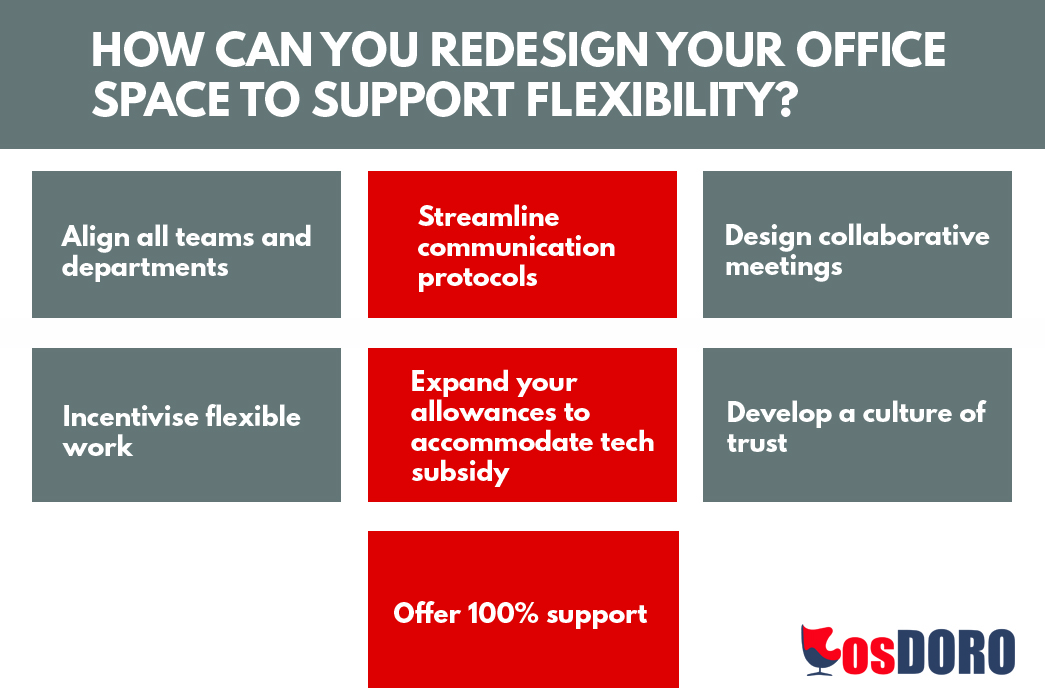
When Singapore’s circuit breaker went into effect on April 7, 2020, all non-essential businesses that could operate from home were required to telecommute. However, many businesses in Singapore had changed their work models and begun working from home, either partially or entirely, since the beginning of the year, when COVID-19 cases first appeared in the country and well before WHO declared the illness a pandemic. As a result, businesses and organisations across the country have had to quickly adapt to working from home, implementing a variety of online collaboration tools along the way.
Opinions within the Singapore workforce are diverse and wide-ranging, as employees consider the unique challenges of working in a world where COVID-19 is still a factor, as well as their job expectations, work model, and future challenges.
7 out of 10 SG Executives Plan to Adopt Hybrid Work Setup

According to the KellyOCG Global Workforce Agility 2021, seven in ten Singapore executives planned to offer their employees hybrid and remote work models, but they are lagging behind in terms of the support they give their employees affected by the pandemic in the new set-up.
According to KellyOCG, of the 13 countries surveyed for the global report, Singapore, which excels at providing training for employees to take on new skills, has the “highest proportion” of executives, at 72 per cent, considering adopting hybrid and remote options even after the pandemic is over.
This is higher than the global average of 58 per cent and the Asia Pacific average of 58 per cent (APAC). In Singapore, 36% of executives intend to make remote work a permanent option, compared to 25% globally and 22% in APAC.
According to KellyOCG, 63 per cent of executives in Singapore recognize the value of a hybrid work model in meeting business goals, and 61 per cent have provided employee training and upskilling, compared to 47 per cent globally and 54 per cent in APAC.
Hybrid Working Model in 2022
As we approach 2022, we can now look back at the previous two years to see what we can leave behind in order to work better and more efficiently. For starters, we have abandoned traditional face-to-face communication in favour of Zoom calls, which we now use as if they were second nature.
While some continue to struggle, we are becoming less reliant on pre-COVID or legacy processes and tools as we adapt to newer and more innovative ways of collaborating despite working apart.
During these two years, there was a decrease in sales and pitch meetings as potential leads waited for pre-COVID normalcy. In addition, there have been fewer company town halls, events, and promotions.
Furthermore, businesses saw a shift from a highly centralised to a distributed workforce. Many internal meetings were held as teams attempted to navigate these uncharted waters, as employees were constantly checking in on statuses and collaboration updates. In addition, teams struggled to collaborate with on-site asset management because they were all located thousands of miles apart.
We believe that by 2022, the current working environment will have vastly improved. With herd immunity hopefully in place by then, we can anticipate an increase in sales or pitch meetings as leads become more comfortable and forecasting becomes easier to project. In addition, we will see an increase in sales, marketing, and promotional activities.
How the Hybrid Model Is Changing the Singapore Work Culture

1. Hybrid work boosts productivity.
The urgency of the COVID-19 crisis meant that work-from-home arrangements were implemented quickly and on a large scale for many companies. As the practice becomes more integrated into Singapore’s work practices, it is critical that companies optimize their approach so that employees receive adequate support when working outside the office.
Beyond the volume of work they can complete when working remotely, the vast majority of employees believe it improves the quality of their output. When it comes to remote work, 88 per cent are satisfied with the quality of their work, while only 12 per cent are dissatisfied.
2. Creating work-life balance remains a challenge.
Despite widespread acceptance of WFH arrangements, one issue remains a challenge for employees: maintaining boundaries between home and work life. When asked if they had set healthy work-life boundaries for themselves, a significant number of respondents (41 per cent) said they had not or had only minimally done so.
This struggle to establish and maintain boundaries may be partly to blame for another survey finding: most employees feel pressured to work more hours at home than they did in the office.
3. More training is required for employees.
Businesses may also want to consider offering training to help employees adjust to new ways of working and make the most of remote work software. 42 per cent of respondents said that this type of training would help them adjust to working outside the office.
The desire for training was particularly strong among mid-level employees. In addition to concerns about excessive work hours, this training would have to be integrated into regular work hours.
4. Changes in decision-making need to be implemented.
Because there is no one-size-fits-all solution, hybrid work is difficult. Even within organisations with diverse business units, one group may need to work from an office while others do not. This frequently results in “us-versus-them” silos, which can quickly become problematic.
Working remotely flattens workplace hierarchies, while returning to the office attempts to reestablish those traditional power structures. Apple employees resisted a top-down decision that would have been acceptable prior to the pandemic.
Flexible Office Spaces for Hybrid Work Arrangements

Is the Hybrid Work Model Here to Stay?
With companies implementing digital transformation and innovations to ensure work continuity in the midst of the Covid-19 situation, industry experts predict that a successful hybrid work environment will be relevant in 2022 as well, even if pandemic fears have subsided.
Employees in the hybrid model work partly on-site or in the office and partly remotely, depending on work requirements and productivity. Certain industries are thriving on the back of the hybrid model in the face of pandemic challenges, and companies are expected to tweak the model in the coming year to get the most out of it.
WFH is the new normal, and businesses are unlikely to return to their old ways of working solely from the office. Because we’re in it for the long haul, make necessary changes in every area, from technology to HR, work operations to culture. Your business will be able to continue and thrive if you make the right technological investments. As a result, it’s more important than ever to keep your technology up to date.
For enquiries, feel free to chat with our team. You may also check out our flexible office space options that are suitable for any type of hybrid work models.

CEO